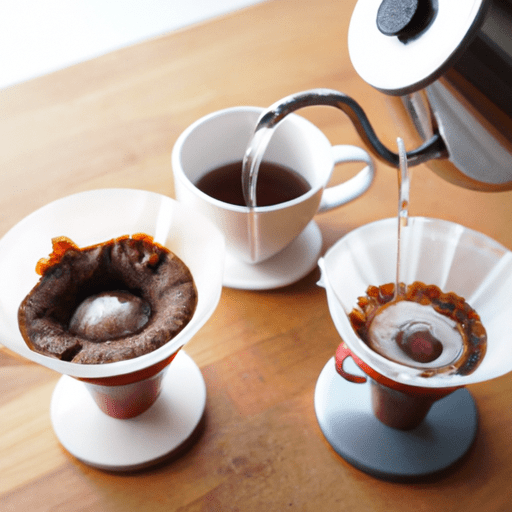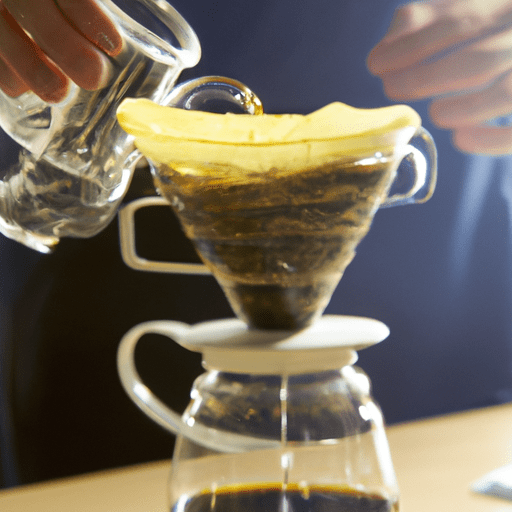You’re about to embark on an exciting journey as you learn the skill of brewing the perfect pour over coffee without the need of a dripper. With a pinch of patience and a hint of creativity, you can masterfully craft a cup of coffee that’s robust in flavor and potent in aroma. Perfect for the coffee enthusiasts and foodies alike, this is where you unlock the secret to getting that barista-level pour over coffee results, right in the comfort of your own kitchen. Learn how to circumvent the need for a dripper, capture the full-bodied flavor of the beans, and embrace each morning with a cup of coffee that’s as flavorful as it is fulfilling.

Choosing the Right Coffee Beans
When it comes to mastering pour over coffee, everything starts with choosing the right coffee beans. Making an exceptional brew at home definitely requires some meticulousness, but don’t worry, with a little knowledge and practice, anyone can do it.
Considering the Roast Level
When you’re out buying coffee beans, one of the first things you should consider is the roast level. Light, medium or dark roast, the choice truly depends on your palate. Light roast tends to have a more nuanced and sharper acidity. Medium roasts, on the other hand, maintain a perfect balance of flavor, aroma, and acidity. Dark roasts are bold, rich and with low acidity. Spend some time experimenting with different roasts to find out what you prefer.
Selecting Specialty Coffee
Next, you should put thought into whether you’d prefer specialty coffee. These are coffees that are grown at high altitudes and have distinctive flavor profiles. They’re meticulously picked and processed. It’s like premium wine, where every cup has a story and flavors that tell it.
Freshness and Grinding
Always ensure that your coffee beans are fresh. Coffee tends to lose its flavor over time and stale coffee can lead to a dull tasting cup. Additionally, only grind your coffee right before you’re ready to brew, as coffee grounds can oxidize and lose their flavor if left out for too long.
Understanding Different Pour Over Methods
There are quite a few methods to making a pour over coffee, and while each one might yield slightly different results, they all allow for you to craft an amazing cup of coffee just the way you like it.
The V60 Method
The V60 method is a tried and true technique that is widely recognized for its reliability. With the use of a V60 dripper and its corresponding filters, this method allows for a clean, high-quality brew.
The Chemex Method
The Chemex, featuring a glass vessel alongside a thicker Chemex filter, can produce a coffee that’s both crisp and bright. It’s an aesthetically pleasing way to make coffee and is celebrated for its ability to highlight the dynamic flavor profiles of various coffee beans.
The Clever Dripper Method
The Clever Dripper combines the best of both the French press and V60 method. It allows the coffee to steep before it is drained, which can result in a sweeter cup and a fuller body. Unlike many other methods, the damage to your wallet is minimal, with affordable options available.
Creating Your Homemade Pour Over Setup
Building your own pour over setup at home can seem a little daunting but don’t worry, you really only need a few key tools.
Equipment Needed
Ideally you’ll need a scale, a gooseneck kettle, a grinder, a dripper, filters, and of course, coffee beans. Having a quality grinder can greatly affect the taste of your coffee.
Improvised Alternatives
There’s no need to worry if you don’t have this equipment available to you though; there are several everyday household items that can be used instead. A saucepan could replace a kettle, a manual grinder instead of electric, or even DIY coffee filters using paper towels.
Setting Up Your Workspace
When you’re setting up your workspace, try to keep it clean, comfortable and organized. Having everything within reach can make the process smoother and more enjoyable.

Preparing the Water and Ratio
The correct water and coffee-to-water ratio can make a significant difference in the taste of your coffee.
Quality of Water
The water you use should be clean and clear. If you’re unsure, it’s best to use filtered water.
Ideal Water Temperature
Generally, your water temperature should be between 195-205 degrees Fahrenheit. Too hot and it could extract unpleasant flavors, too cold and your coffee might be under-extracted.
Coffee-to-Water Ratio
A general guideline to follow is 1:15, which is 1 part coffee to 15 parts water. However, feel free to adjust this based on your taste preferences.
Blooming and the Pouring Technique
Blooming your coffee is critical to the pour over process, and so is mastering a good pouring technique.
The Importance of Blooming
Blooming your coffee is simply pre-wetting your coffee grounds. This important step allows for gas (which can interfere with extraction) to escape, and also ensures all coffee grounds are wet and ready to extract effectively.
Blooming Duration
Typically, the blooming process takes about 30 to 45 seconds and involves pouring enough water to wet all the coffee grounds.
Mastering the Pouring Technique
Pouring in a slow, circular motion ensures that all grounds are included in the brewing process, which can enhance the flavor of your coffee.
Controlling Brew Time and Extraction
The time taken to brew as well as how well the coffee’s substances are extracted make a big difference in the flavor of your coffee.
Adjusting Grind Size
The size of your grind matters. A finer grind can lead to a stronger cup, while a coarser grind can produce a softer, weaker coffee. Slight changes in grind size can drastically affect the extraction and subsequently, the taste of your coffee.
Factors Affecting Brew Time
Brew time can be affected by several factors such as grind size, coffee-to-water ratio, pour rate, and water temperature. Normally, you should aim for a brew time of 2.5 to 3 minutes, depending on your tastes.
Monitoring Extraction
You need to monitor the extraction process to ensure that the flavors are being pulled out from the coffee at the ideal rate. Under-extraction leads to sour coffee, while over-extraction will make your coffee taste bitter.
Achieving Consistency in Pour Over
Consistency is key when it comes to making the perfect cup of coffee.
Developing a Recipe
Once you’ve found the coffee-to-water ratio, grind size and brew time that suits your taste preferences best, it’s worth documenting your process. This will be your go-to recipe for a consistent brew each time.
Practice and Experimentation
Like any skill, practice makes perfect. Don’t be afraid to experiment with different variables like water temperature, grind size, and coffee-to-water ratio to find what suits your taste.
Noting Adjustments for Future Brews
Note down any adjustments you’ve made to the recipe. This will not only help you remember what worked and what did not, but also save you time in the future.
Exploring Flavor Profiles and Tasting Notes
Being able to identify different flavor profiles and noting tasting notes can really enhance your coffee experience.
Recognizing Flavor Characteristics
Flavor characteristics vary from coffee to coffee. They can range from fruity and acidic to nutty and sweet. It’s an exciting world to explore and truly get to know your favorite brew.
Documenting Tasting Notes
Writing down your observations of your coffee’s smell, taste, and texture can enhance your understanding and appreciation of it. Document these details and refer back to them whenever you want to recreate a particular brew.
Pairing Food with Your Pour Over
Pour over coffee pairs well with many foods due to its versatility in flavor profiles. Knowing which foods complement your coffee’s taste can further enrich your pour over experience.
Troubleshooting Common Pour Over Issues
From time to time, you may encounter challenges; that’s part of the journey! Here are a few to look out for:
Uneven Extraction
If your coffee has a sour or bitter taste, you might be dealing with uneven extraction. This often occurs when the coffee grounds are not all the same size.
Channeling
Channeling is when water finds an easier path through your coffee grounds, causing over-extraction in some parts and under-extraction in others. To avoid this, ensure your coffee bed is flat before brewing.
Over or Under Extraction
Over or under extracted coffee isn’t desirable. It can taste harsh and bitter or weak and sour. Ensuring a proper grind, accurate water temperature, and correct brew time will help prevent this.
Cleaning and Maintaining Your Homemade Setup
To keep producing quality coffee and prolong the life of your gear, cleaning and maintenance are crucial.
Tips for Cleaning
Regularly clean your equipment after each use. Rinsing with warm water usually does the job, but for a deeper clean, consider using a mild detergent.
Regular Maintenance
Over time, residual oils and coffee grounds may leave behind build-ups that could affect the taste of your coffee. Regularly descaling your kettle and grinder will keep your gear performing at its best.
Replacing Components
Watch out for wear and tear on your equipment. Filters need to be replaced after each use, and other parts like the grinder burrs or kettle might need periodic replacement too.
With patience, practice, and a little bit of coffee geekery, anyone can master the art of pour over coffee at home. So, get out there, explore and experiment, and most importantly, enjoy the process!
